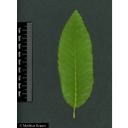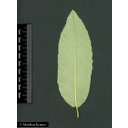Useful information about the taxon (species, subspecies, variety...)
Quercus variabilis Blume 1851
Fagaceae
(APG IV)Oriental oak, Chinese cork oak
Akzessionnummer: LG-T-153-18621
Pflanzjahr: 2003
Patenschaftstext: Für Adrian Sievert Blauß * 10. 5. 05
Taxon concept: The Plant List (2014), version 1.1
Distribution: Japan, Korea, North China, Taiwan
Size: 23 - 27 (m)Flowering period: III - IV
Quercus variabilis Blume - Accepted: Quercus variabilis Blume bei The Plant List (2014), version 1.1; Familie: Fagaceae (APG III)Quercus variabilis Blume - Accepted: Quercus variabilis Blume bei Zander 2008; Familie: Fagaceae (Zander 2008)
- Color of flower
- yellow-green
- Flowers
- monoecious
- Flower ecology
- wind-pollinated (anemophilous)
- Life form
- tree
- Leaves
- ovate-lanceolate to narrowly elliptic; lower surface (abaxially) densely stellate tomentose
- Foliage persistence
- deciduous
- Fruits
- acorn with cupule; nut subglobose to broadly ovate
- Soil conditions
- preferentially on moist, well-drained loam soils
- Natural occurrence (habitat)
- mixed forests
- Vegetation typ and synecology (plant community)
- temperate to subtropical broad-leaved deciduous to evergreen forests
- Usage
- bark is commercially used for the production of cork; wood is used for boat making and construction; also used as ornamental tree
- Bark
- yellowish-grey, thick and furrowed
The International Plant Names Index (2009). Published on the Internet http://www.ipni.org; Courtesy to IPNI, 2009. Exported from IPNI at date: 2009-09-22 20:17:51; The IUCN Red List of Threatened Species. www.iucnredlist.org;
Diese Webseite verwendet Google Maps, um Karten und Standorte von Pflanzen in den Hohenheimer Gärten anzuzeigen. Dadurch werden unter Umständen Daten an Google weitergeleitet, was mit einer Verarbeitung Ihrer personenbezogenen Daten verbunden sein kann. Die Datenschutzerklärung von Google finden Sie hier: Datenschutzerklärung von Google


